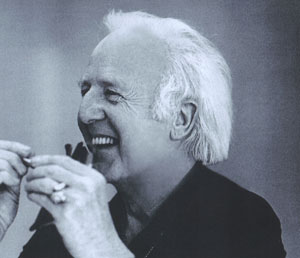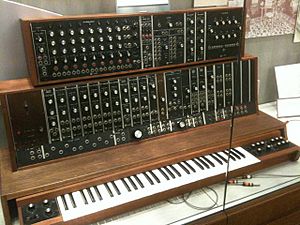Alwin Nikolais facts for kids
Quick facts for kids
Alwin Nikolais
|
|
|---|---|

Alwin Nikolais, photographed by Ralph E. Sandler
|
|
| Born | November 25, 1910 Southington, Connecticut, U.S.
|
| Died | May 8, 1993 (aged 82) New York City, New York, U.S.
|
| Occupation |
|
| Partner(s) | Murray Louis |
Alwin Nikolais (born November 25, 1910 – died May 8, 1993) was an American choreographer, dancer, and composer. He was also a musician and a teacher. Nikolais created the famous Nikolais Dance Theatre. He was known for his amazing and new ideas for costumes, lighting, and stage designs. People called him the "father of multi-media theater" because he brought a fresh vision to dance.
Contents
Early Life and Inspiration
Alwin Nikolais was born on November 25, 1910, in Southington, Connecticut. He started learning to play the piano when he was very young. His first performances were as an organist, playing music for silent movies.
As a young artist, he learned many skills. These included designing sets for plays, acting, making puppets, and composing music. He decided to study dance after watching a performance by the German dancer Mary Wigman. He trained at Bennington College with famous modern dance artists. Some of his teachers were Hanya Holm, Martha Graham, Doris Humphrey, and Charles Weidman.
Building a Dance Career
In 1939, Nikolais created his first ballet called Eight Column Line. He worked with Truda Kaschmann, who was his first modern dance teacher. After teaching at his own studio and touring with Hanya Holm's company, Nikolais served in the United States Army during World War II.
After the war, Nikolais moved to New York City. He continued to study with Hanya Holm and later became her assistant. He taught at her New York school and at Colorado College during the summers.
The Nikolais Dance Theatre
In 1949, Nikolais became a co-director at the Henry Street Settlement Playhouse. He started the Playhouse Dance Company there. This company later became known as the Nikolais Dance Theatre. At Henry Street, Nikolais began to develop his unique style of abstract dance. He saw people as part of a complete environment on stage.
Nikolais believed that dance was "the art of motion." He said that movement itself could be the message. He also stated that art should explore life's deeper parts. Murray Louis joined Nikolais at Henry Street Playhouse. Louis became a key dancer and a long-time partner in the company.
International Recognition
In 1956, the Nikolais Dance Theater performed at the American Dance Festival. They also appeared on television shows like The Steve Allen Show. His "total dance theatre" style became well-known. The company quickly became a leader in American contemporary dance. In the 1960s, his choreography was shown on live TV again for the CBS Repertoire Workshop.
Nikolais was always looking for new ideas. In 1964, he saw the first Moog electronic music system. He immediately ordered one to use in his shows.
The company's performances in Paris in 1968 helped Nikolais become famous worldwide. After Paris, the company started performing all over the globe. He had a long artistic relationship with the Théâtre de la Ville in Paris, starting in 1971.
In 1978, the French government asked him to create a dance center in Angers, France. In 1980, he created his 99th dance work, Schema, for the Paris Opera. At the same time, he choreographed an opera in Vienna.
Nikolais received many honors, including five honorary doctorate degrees. He was also given grants from important foundations. Many films and TV shows have featured Nikolais and his work. In 1987, a documentary film called Nik and Murray was shown on PBS. It was about Nikolais and Murray Louis.
Nikolais was also a respected teacher. His teaching methods are still used in schools and universities today. He passed away from cancer on May 8, 1993, in New York. He is buried in Paris.
Nikolais' Unique Style
Nikolais used lights, slides, electronic music, and stage props in his shows. He created special environments where dancers moved and blended in. He often used props that were both beautiful and useful. For example, a moving curtain might hide a dancer crossing the stage. It would also create a sense of movement in the space.
His show MASKS, PROPS, and MOBILES helped make modern multimedia theater popular. Some critics did not see his work as traditional dance. This was especially true when he covered dancers in plastic bags in a piece called Noumenon. The bags would stretch and change shapes.
Nikolais avoided common themes like good versus evil. Instead, he focused on group actions rather than individual stories. He also developed his own movement style. He did not copy moves from the past or other artists. He expanded how music was used in dance. It was not just for timing or emotion. He created new sounds for his unique theater environments. He was the first person to buy the new Moog synthesizer in 1964.
Decentralizing the Dancer
Nikolais believed that meaning should come only from movement. He said his stage shows "decentralized" the dancer. This meant that humans were just one part of the many elements on stage. Nikolais did not like how modern dance often focused too much on the individual dancer.
He preferred a barefoot dance technique. He thought it was practical because bare feet help with muscle use and feeling the ground. He often included this in his costume designs. For example, in "Discs," dancers wore colored aluminum discs on one foot. These discs made the dancers' base wider and added height. Their shape, color, and material also created visual and sound effects. In other works, dancers wore sound-making circles on their feet. This changed their movement to create sounds.
Nikolais focused on sensory experience. He believed that how an audience perceived one area could be emphasized. This was done by purposely blocking out other unwanted areas. In the 1950s, he used different colored makeup. This was to create or prevent sensory blocking. It also changed how people perceived race in dances like Prism and Imago. He used makeup for design, not to create specific characters.
Lights, Music, and Reputation
Nikolais used lighting a lot. He directed light from many directions and levels. He used it to create shapes, spaces, and silhouettes. He also composed his own electronic music for his dances. At the Henry Street Playhouse, a seven-speaker system played the music. This made the sound feel like it was coming from all over the room. By combining dancers, lighting, and music, he became famous worldwide for his theatrical art. Many universities and organizations praised Nikolais.
Nikolais was known for being shy and quiet among his friends. He let his partner, Murray Louis, handle public matters. Nikolais preferred to focus on his school and theater. He was a master teacher, and his teaching methods are still used globally. He encouraged his students to aim for high artistic values. He wanted them to be creative and skilled.
Awards and Honors
In 1987, President Ronald Reagan gave Nikolais the National Medal of Arts. He also received the Kennedy Center Honors. This award included a special TV show on CBS featuring the Nikolais Dance Theater.
He received the highest honor from the City of Paris, the Grande Medaille de Vermeille de la Ville de Paris. He also got medals from cities like Seville, Spain, and Athens, Greece. New York City's Mayor gave him a special award, which he shared with Murray Louis. Nikolais is known as the "American Patriarch of French modern dance." He was made a knight of France's Legion of Honor. He was also a commander of the Order of Arts and Letters. In 2000, he was added to the National Museum of Dance and Hall of Fame.
His other awards included the Samuel H. Scripps American Dance Festival Award and the Capezio Award. He also received the Dance Magazine Award in 1968 and the American Dance Guild Award.
Famous Choreographies
Nikolais' first major show after creating the Henry Street Settlement Playhouse was Kaleidoscope (1953). It premiered at the American Dance Festival.
- 1953, Kaleidoscope
- 1953, Masks, Props, and Mobiles
- 1953, Tensile Involvement
- 1953, Noumenon Mobilus
- 1955, Noumenon
- 1960, Totem
- 1963, Imago suite
- 1963, Arcade
- 1963, Artisan
- 1964, Sanctum
- 1964, Water Studies
- 1978, Gallery
- 1979, Count Down
- 1980, Mechanical Organ
- 1982, Dime in the Slot (part of Mechanical Organ)
- 1982, Pond
- 1982, Two not yet together
- 1985, Crucible
- 1987, BLANK on BLANK
- Girls Trio
- Mantis
See Also
In Spanish: Alwin Nikolais para niños


